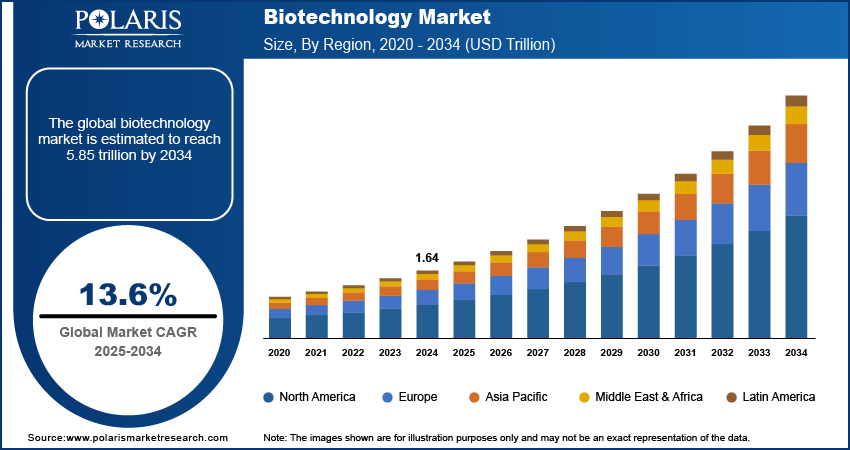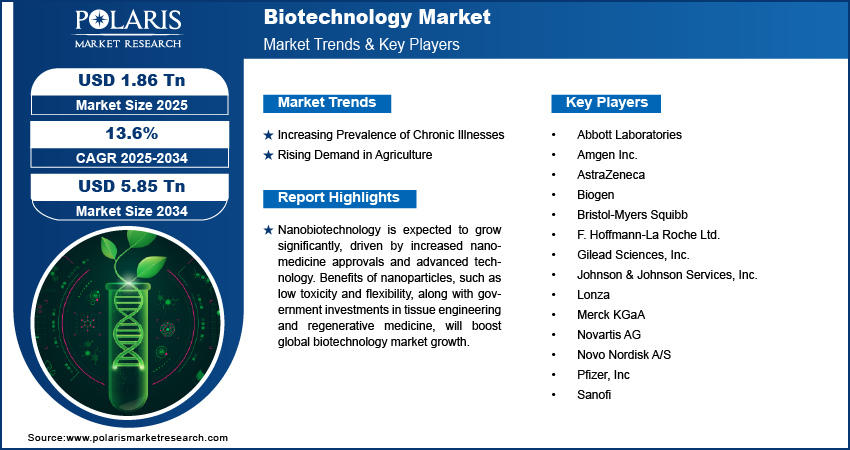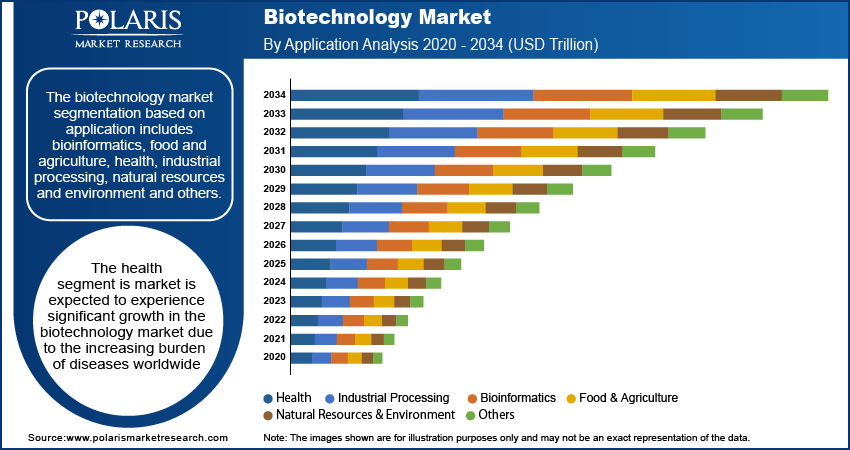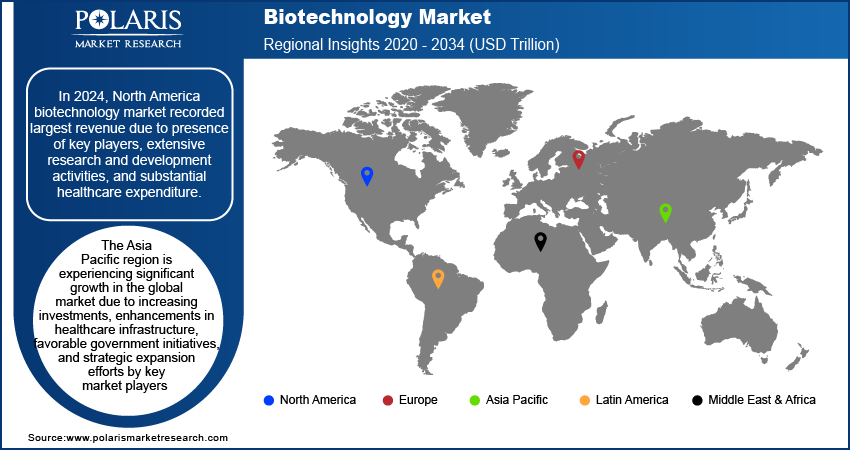
Biotechnology Market Size, Share, Trends, Industry Analysis Report: By Technology, Application (Bioinformatics, Food & Agriculture, Health, Industrial Processing, Natural Resources and Environment, Others) and Region (North America, Europe, Asia Pacific, Latin America, and Middle East & Africa) – Market Forecast, 2025–2034
- Published Date:Dec-2024
- Pages: 125
- Format: PDF
- Report ID: PM1011
- Base Year: 2024
- Historical Data: 2020-2023
Biotechnology Market Overview
Biotechnology market size was valued at USD 1.64 trillion in 2024. The industry is projected to grow from USD 1.86 trillion in 2025 to USD 5.85 trillion by 2034, exhibiting a compound annual growth rate (CAGR) of 13.6% during the forecast period.
Biotechnology is the use of biological systems, organisms, or derivatives to develop or create products and technologies that benefit society. It combines knowledge from fields like biology, chemistry, and engineering to solve problems in areas such as medicine, agriculture, and environmental sustainability.
Government initiatives promoting regulatory modernization, streamlined approval processes, and enhanced reimbursement policies, along with standardized clinical studies, propel the market. The rise of personalized medicine and the expanding portfolio of orphan drug formulations create opportunities for biotechnology applications, attracting emerging innovative companies and contributing to market revenue growth.

To Understand More About this Research: Request a Free Sample Report
A robust clinical trial pipeline and available funding opportunities in tissue engineering and regeneration technologies propel the biotechnology market. According to the Alliance for Regenerative Medicine, companies involved in cell and gene therapies received over USD 23.1 trillion in global investments in 2021, marking a 16% increase from the previous year's total of USD 19.9 trillion. The clinical success of key gene therapy players in 2021, such as positive outcomes from Intellia Therapeutics and Regeneron's in vivo CRISPR treatment for transthyretin amyloidosis, has a substantial impact on market growth.
Biotechnology Market Driver Analysis
Increasing Prevalence of Chronic Illnesses
Over time, there has been a rise in the prevalence of chronic diseases, attributed in part to an increasingly sedentary lifestyle accompanying the expansion of the middle class and accelerated urbanization. This trend contributes to higher rates of obesity and the increased occurrence of diseases such as malaria, HIV, diabetes, TB, and genetic abnormalities. The market is further driven by a growing frequency of target diseases and genetic anomalies, ongoing technological advancements in polymerase chain reaction technologies, and increased investments, funding, and grants for scientific research. The bio-pharmacy industry plays a crucial role in preventing chronic diseases, with a focus on developing personalized treatments. This approach is expected to pave the way for individualized procedural healthcare requirements and contribute to the treatment of hereditary genetic diseases. Additionally, innovative concepts like cell therapy are being introduced to the market, showing potential for efficient treatment of certain cancers.
Rising Demand in Agriculture
The market experiences growth due to rising demand for biotechnology tools in agricultural applications, such as micro-propagation, molecular breeding, tissue culturing, conventional plant breeding, and the development of genetically modified crops. The increasing popularity of genetically modified crops, herbicide-tolerant, and insect-resistant seeds further contributes to market expansion. The adoption of tissue culture technology for producing novel rice variants and disease- and pest-free banana varieties in South Asia and Africa, along with its use in cloning disease-free and nutritious plant varieties, drives the application of biotechnology in agriculture, thereby driving the biotechnology market value.

Biotechnology Market Segment Analysis
Biotechnology Market Assessment by Technology Outlook
The biotechnology market segmentation based on technology includes fermentation, tissue engineering and regeneration, chromatography, PCR technology, nanobiotechnology, cell-based assays, DNA sequencing and others. The DNA sequencing segment accounted for largest share in 2024 due to increase in government fundings in the genetic research. government funding in genetic research has facilitated the expanded applications of sequencing, facilitating a better understanding of diseases. For instance, in May 2021, the University of Pittsburgh Graduate School of Public Health and Washington University School of Medicine received a USD 10.7 trillion NIH grant for the exploration of the genetic foundation of Alzheimer's disease, showcasing an increase in funding genetic research, thereby driving the segmental growth in the global biotechnology market report.
Nanobiotechnology is anticipated to experience substantial growth at a high CAGR during the forecast period, propelled by the increasing approvals of nanomedicine and the introduction of advanced technology. The advantages of nanoparticles, such as low toxicity, smaller size, and chemical flexibility, prove beneficial in overcoming limitations associated with traditional routes of generic drug administration. Additionally, the field of tissue engineering and regenerative medicine commands a noteworthy share, supported by both government and private investments, substantial healthcare expenditure, and the presence of a significant number of established and emerging players. These factors are expected to propel growth in this segment throughout the forecast period in the global biotechnology market.
Biotechnology Market Evaluation by Application Outlook
The biotechnology market segmentation, based on application, includes bioinformatics, food and agriculture, health, industrial processing, natural resources and environment and others. The health segment is market is expected to experience significant growth in the biotechnology market due to the increasing burden of diseases worldwide. The global population is aging, and the prevalence of chronic conditions like cancer, diabetes, and heart disease is rising, due to which there is a growing demand for advanced medical treatments and therapies. Biotechnology plays a key role in developing innovative medicines, vaccines, and diagnostic tools to address these health challenges. Additionally, advancements in personalized medicine and gene therapies are further driving the growth of this segment in the biotechnology market.

Biotechnology Market Share by Regional
By region, the study provides the biotechnology market insights into North America, Europe, Asia Pacific, Latin America, and the Middle East & Africa. In 2024, North America had the largest revenue share in the biotechnology market. The growth of the regional market is driven by various factors, including the presence of key players, extensive research and development activities, and substantial healthcare expenditure. The region exhibits a notable penetration of genomics, proteomics, and cell biology-based platforms, thereby accelerating the adoption of life sciences tools. Additionally, the increasing prevalence of chronic diseases and the growing adoption of personalized medicine applications for treating life-threatening disorders are anticipated to have a positive impact on biotechnology market growth in the North America region.

The Asia Pacific region is experiencing significant growth in the global market. This growth is attributed to increasing investments, enhancements in healthcare infrastructure, favorable government initiatives, and strategic expansion efforts by key market players. Notably, in February 2022, Moderna Inc. disclosed plans for a geographic expansion of its commercial network in Asia, establishing new subsidiaries in Malaysia, Singapore, Hong Kong, and Taiwan. Furthermore, collaborations in the biopharmaceutical sector, such as the strategic partnership between Kiniksa Pharmaceuticals and Huadong Medicine for the development and commercialization of Kiniksa's ARCALYST and mavrilimumab in the Asia-Pacific region, showcasing the strategic expansion efforts by key market players. These factors, in turn, are driving the growth of the biotechnology market in the Asia Pacific region
Biotechnology Market Key Players & Competitive Analysis Report
The biotechnology market is constantly evolving, with numerous companies striving to innovate and distinguish themselves. Leading global corporations dominate the market by leveraging extensive research and development, and advanced techniques. These companies pursue strategic initiatives such as mergers, acquisitions, partnerships, and collaborations to enhance their product offerings and expand into new markets.
New companies are impacting the industry by introducing innovative products to meeting the demand of specific market sectors. This competitive environment is amplified by continuous progress in product offerings. Major players in the biotechnology market, includes, Abbott Laboratories; Amgen Inc.; AstraZeneca; Biogen; Bristol-Myers Squibb; F. Hoffmann-La Roche Ltd.; Gilead Sciences, Inc.; Johnson & Johnson Services, Inc.; Lonza; Merck KGaA; Novartis AG; Novo Nordisk A/S; Pfizer, Inc and Sanofi.
Roche, officially known as F. Hoffmann-La Roche Ltd, is a biotechnology firm dedicated to advancing medical solutions for various significant ailments. Its focus encompasses the development of drugs and diagnostic tools to combat major diseases, such as cancer, autoimmune disorders, central nervous system conditions, eye-related afflictions, infectious ailments, and respiratory issues. Roche also provides comprehensive diabetes management solutions, in vitro diagnostic systems, and cutting-edge cancer diagnostics based on tissue analysis. The company's operational structure revolves around two key segments: diagnostics and pharmaceuticals. Under the pharmaceutical domain, Roche concentrates on creating innovative medications in oncology, immunology, ophthalmology, infectious diseases, and neuroscience. Roche specializes in disease identification via in vitro diagnostic procedures in the diagnostic realm. Roche's pursuits extend to pioneering research and exploration of novel disease prevention, detection, and treatment strategies. Its broad range of offerings caters to diverse stakeholders, including hospitals, commercial laboratories, healthcare practitioners, researchers, and pharmacists.
Novartis AG is a healthcare company that specializes in the development and manufacture of generic pharmaceuticals and eye care products. With a global presence in 140 countries, it offers a wide range of products for the treatment of various medical conditions, including cancer, neurological disorders, cardiovascular diseases, respiratory diseases, hematologic diseases, immune disorders, infections, and dermatological conditions. The company has a strong focus on therapeutic areas such as renal, metabolic, cardiovascular, neuroscience, immunology, and oncology, as well as ophthalmology and hematology. The company has a collaboration and license agreement with Alnylam Pharmaceuticals to develop, manufacture, and commercialize inclisiran, a therapy to reduce LDL cholesterol. The Innovative Medicines division is responsible for researching, developing, manufacturing, distributing, and selling patented pharmaceuticals. This segment comprises two business units: Novartis Pharmaceuticals and Novartis Oncology. These units are dedicated to bringing new and innovative treatments to patients suffering from various diseases, including cancer, cardiovascular diseases, and neurological disorders.
Key Companies in the Biotechnology Market include
- Abbott Laboratories
- Amgen Inc.
- AstraZeneca
- Biogen
- Bristol-Myers Squibb
- F. Hoffmann-La Roche Ltd.
- Gilead Sciences, Inc.
- Johnson & Johnson Services, Inc.
- Lonza
- Merck KGaA
- Novartis AG
- Novo Nordisk A/S
- Pfizer, Inc
- Sanofi
Biotechnology Market Developments
In October 2024, The Unified Website for Biotechnology Regulation was launched by the USDA, EPA, and FDA, providing information on regulatory requirements for GM microorganisms, aiming to enhance transparency and coordination in biotech regulation.
In May 2023, Gilead Sciences, Inc. announced the completion of its acquisition of XinThera, obtaining all outstanding shares. This strategic maneuver bolsters Gilead's clinical development goals by integrating complementary pipeline assets concentrated on validated targets in oncology and inflammation.
In January 2023, Gero and Pfizer have initiated a strategic research collaboration, leveraging Pfizer's domain expertise and Gero's advanced technology platform. This partnership is focused on uncovering genes and pathways linked to fibrotic diseases, representing a notable advancement in the biotechnology market.
Biotechnology Market Segmentation:
By Technology Outlook (Revenue USD Trillion, 2020–2034)
- Fermentation
- Tissue Engineering and Regeneration
- Chromatography
- PCR Technology
- Nanobiotechnology
- Cell-based Assays
- DNA Sequencing
- Others
By Application Outlook (Revenue USD Trillion, 2020–2034)
- Bioinformatics
- Food & Agriculture
- Health
- Industrial Processing
- Natural Resources & Environment
- Others
By Regional Outlook (Revenue USD Trillion, 2020–2034)
- North America
- US
- Canada
- Europe
- Germany
- France
- UK
- Italy
- Spain
- Netherlands
- Russia
- Rest of Europe
- Asia Pacific
- China
- Japan
- India
- Malaysia
- South Korea
- Indonesia
- Australia
- Rest of Asia Pacific
- Middle East & Africa
- Saudi Arabia
- UAE
- Israel
- South Africa
- Rest of Middle East & Africa
- Latin America
- Mexico
- Brazil
- Argentina
- Rest of Latin America
Biotechnology Market Report Scope
|
Report Attributes |
Details |
|
Market size value in 2024 |
USD 1.64 trillion |
|
Market size value in 2025 |
USD 1.86 trillion |
|
Revenue Forecast in 2034 |
USD 5.85 trillion |
|
CAGR |
13.6% from 2025–2034 |
|
Base year |
2024 |
|
Historical Data |
2020–2023 |
|
Forecast Period |
2025–2034 |
|
Quantitative Units |
Revenue in USD trillion and CAGR from 2025 to 2034 |
|
Report Coverage |
Revenue Forecast, Market Competitive Landscape, Growth Factors, and Trends |
|
Segments Covered |
|
|
Regional Scope |
|
|
Competitive Landscape |
|
|
Report Format |
|
|
Customization |
Report customization as per your requirements with respect to countries, region and segmentation. |
FAQ's
The Biotechnology Market size was valued at USD 1.64 trillion in 2024 and is projected to grow to USD 5.85 trillion by 2034
The global market is projected to grow at a CAGR of 13.6% during the forecast period, 2025-2034.
North America had the largest share in the global market in 2024.
The key players in the market are Abbott Laboratories; Amgen Inc.; AstraZeneca; Biogen; Bristol-Myers Squibb; F. Hoffmann-La Roche Ltd.; Gilead Sciences, Inc.; Johnson & Johnson Services, Inc.; Lonza; Merck KGaA; Novartis AG; Novo Nordisk A/S; Pfizer, Inc and Sanofi.
The DNA sequencing segment accounted for largest share in 2024 due to increase in government fundings in the genetic research
The health segment is market is expected to experience significant growth in the biotechnology market due to the increasing burden of diseases worldwide.
